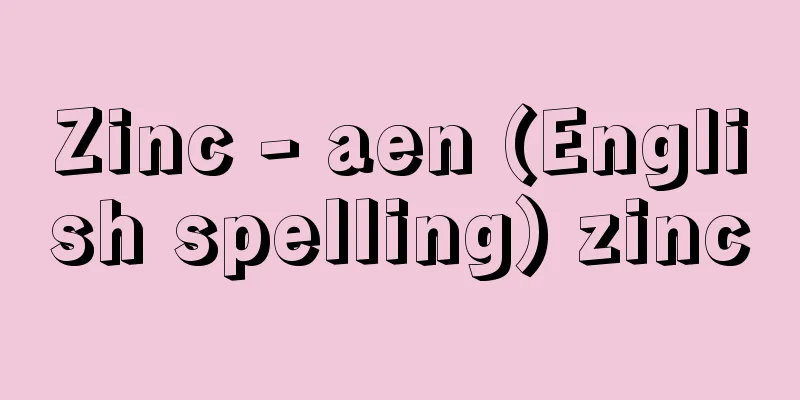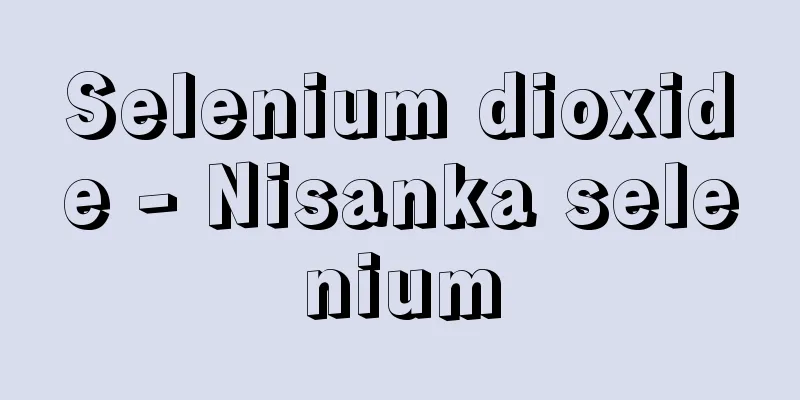Zinc - aen (English spelling) zinc

|
It belongs to group 12 of the periodic table and is one of the zinc group elements. It is widely distributed in the earth's crust, but the amount is not so large. It does not occur as a free metal, and its main ores are sphalerite (ZnS), smithsonite (ZnCO 3 ), and hemimorphite (Zn 4 (OH) 2 Si 2 O 7・H 2 O). [Nakahara Katsunori] historyBrass, an alloy of zinc and copper, has been known since ancient times, with evidence of its use dating back to around 4000 BC. Brass, which has a low zinc content, is beautiful in color and has excellent mechanical properties, making it widely used; there are records of it being used for coins in ancient Rome. However, metallic zinc was extracted much later, and it is believed that the smelting method was developed in India or China, with old zinc coins and ornaments remaining in China. It was introduced to Europe in the first half of the 17th century, and a smelting plant was established in England in the 18th century, after which large-scale production began. It is recorded as "Wa-lead" in the old Chinese industrial technology book "Tenko Kaibutsu" (1637), and in Japan it is recorded as "Jinkiyum, zinc" in Udagawa Yoan's "Seimi Kaisou" (1837-1847). [Nakahara Katsunori] Manufacturing methodThe main raw material is sphalerite, and first impurities such as iron and lead are removed by flotation to produce a concentrate. This is then oxidized and burned to produce cinders (oxide). There are dry and wet methods for processing cinders. In the dry method, zinc is mixed with coke and heated and reduced in a fireclay retort at about 1300°C, and the resulting zinc is distilled. The crude zinc obtained after cooling has a purity of about 98.5% and is called spelter. The main impurities are usually iron, lead, cadmium, etc., and if it is re-distilled, it becomes about 99.99% pure. The zinc obtained by this method is called distilled zinc. The wet method is a method of electrolytic refining in an acidic aqueous solution of sulfuric acid. That is, the cinders are treated with sulfuric acid from the electrolytic waste liquid to extract zinc, and the impurities are removed by precipitating, and then electrolysis is performed using an insoluble lead plate as the anode and a zinc or aluminum plate as the cathode, and the zinc is precipitated on the cathode plate. The zinc obtained by this method is called electrolytic zinc. The electrolytic method is suitable for obtaining high purity products, with purity of 99.99% to 99.998%. [Nakahara Katsunori] natureZinc is a silvery-white, bluish metal that melts easily and volatilizes easily. Its crystal structure is a hexagonal close-packed lattice. It is somewhat brittle and difficult to work, but at 100-150°C, its malleability and ductility increase significantly, making it easy to work into thin plates and wires. At temperatures above 200°C, it becomes brittle again and can be made into powder. Its electrical resistivity is 5.916× 10-6 Ω・cm (20°C). It is diamagnetic. It is stable in dry air, but in moist air or in water in the presence of air, it slowly reacts to form a hydroxide. 2Zn + 2H2O + O2 When heated with a concentrated alkaline aqueous solution, hydrogen is generated to produce zincate. Zn + 2KOH + 2H2O - → Most zinc compounds have an oxidation number of +II. The oxides and hydroxides are amphoteric compounds, and dissolve in both acids and alkalis. In addition, the d-shell (the electron shell that constitutes the d-orbital among the electron orbitals involved in chemical bonds. Compounds of ions with unsaturated d-shells are often colored) are completely filled, so the compounds are generally colorless. It is easy to form compounds with the same structure as magnesium compounds. The coordination form of the complex ion is tetrahedral 4-coordination and octahedral 6-coordination. [Nakahara Katsunori] ApplicationsGalvanized iron, which is a thin iron plate covered with a thin layer of zinc, is used to prevent corrosion by covering the iron with zinc, which has a higher tendency to ionize than iron, and is widely used for roofing sheets and various containers. Brass is an alloy of copper and has beautiful colors, is easy to cast and process, and has excellent mechanical properties such as malleability and ductility, so it is used in machines, daily necessities, crafts, etc. as wire, plate, tube, etc. Zinc die-cast alloys, which are alloys with small amounts of aluminum and copper (for example, Al 3.5-4.5%, Cu 0.75-1.25%, Mg 0.02-0.08%, and the remainder Zn), are used for automobile parts, instruments, etc., and are also used as alloys for nickel silver (nickel silver). Zinc dust is a precipitant in the cyanide process, a hydrometallurgical method for gold and silver. When zinc reacts with dilute acid, hydrogen is generated. This nascent hydrogen is used as a reducing agent, and alkyl compounds are important as reagents for organic synthesis. [Nakahara Katsunori] Zinc and the human bodyThe human body contains about 2 grams of zinc, and it is one of the trace minerals that must be ingested through the diet. It is a component of over 200 types of enzymes and is closely related to enzyme action. A zinc deficiency can cause growth disorders, hepatic and biliary diseases, impaired immune function, taste disorders, and dermatitis. Zinc is found in large amounts in rice bran, germ, beans, and seeds, but zinc tends to be in short supply due to changes in dietary habits such as externalization (eating out, increased use of pre-prepared foods and processed foods, etc.). The Dietary Reference Intakes for Japanese (Ministry of Health, Labor and Welfare) sets out the approximate and recommended amounts for the amount that should be taken through the diet, as well as the upper limit to reduce the risk of health problems due to excessive intake. [Yonago, Yamaguchi] "Life and Metals" by Eiichiro Ochiai (1991, Kyoritsu Publishing) ▽ "Nutrition of Minerals and Trace Elements" edited by Tsuguyoshi Suzuki and Osamu Wada (1994, Daiichi Publishing) ▽ "Clinical Studies of the Digestive System - Clinical Studies of Zinc Vol. 2 - No. 1" (1999, Van Medical) ▽ "Easy Inorganic Chemistry Learned in Exercise Format" by Masahiro Maeno (1999, Shokabo Publishing) ▽ "Inorganic Chemistry" by Nozomi Uchida, Takayuki Komatsu, Hiromitsu Kozuka, Hidetoshi Saito, Yasuo Ikuma, and Yasuhiko Benino (2000, Asakura Publishing) ▽ "Encyclopedia of Minerals" edited by Yoshinori Itokawa (2003, Asakura Publishing) ▽ "Experimental Chemistry Lectures 18/Synthesis of Organic Compounds" 5th Edition edited by the Chemical Society of Japan (2004, Maruzen) ▽ "Akira Hishida and Satoshi Sasaki (eds.), "Dietary Reference Intakes for Japanese 2015 Edition -- Report of the Ministry of Health, Labor and Welfare "Dietary Reference Intakes for Japanese" Formulation Review Committee" (2014, Daiichi Publishing) [Reference items] | | | | | | | | | | | |smelting| |orochemical | | | | | | [Supplementary information] |©Shogakukan "> Periodic Table ©Shogakukan "> Zinc manufacturing process When heated strongly in air, it burns emitting a greenish-white light . Zinc combustion experiment Source: Shogakukan Encyclopedia Nipponica About Encyclopedia Nipponica Information | Legend |
|
周期表第12族に属し、亜鉛族元素の一つ。地殻中には広く分布しているが、存在量はさほど多くない。遊離した金属としては産せず、主要鉱石は閃亜鉛鉱(せんあえんこう)ZnS、菱亜鉛鉱(りょうあえんこう)ZnCO3、異極鉱(いきょくこう)Zn4(OH)2Si2O7・H2Oなどである。 [中原勝儼] 歴史亜鉛と銅の合金である真鍮(しんちゅう)(黄銅)はきわめて古くから知られ、紀元前4000年ごろにも使われていた痕跡(こんせき)がある。亜鉛の含有量の少ない真鍮は黄金色で美しく、しかも機械的性質が優れていて、広く使われており、古代ローマで貨幣に使われていた記録もある。しかし金属亜鉛として取り出されたのは、それよりかなりあとであり、インドないし中国で製錬法が発展したとされており、中国には古い亜鉛の貨幣や装飾品が残されている。17世紀前半にはヨーロッパに伝わり、18世紀にはイギリスで製錬工場が設立され、以後、大規模製造が行われるようになった。中国の古い産業技術書『天工開物(てんこうかいぶつ)』(1637)には「倭鉛」と記されており、日本では宇田川榕菴(うだがわようあん)の『舎密開宗(せいみかいそう)』(1837~1847)には「聖究母(ジンキユム)、亜鉛」と記されている。 [中原勝儼] 製法閃亜鉛鉱が主要原料であるが、まず鉄、鉛などの不純物を浮遊選鉱法などにより除き精鉱とする。ついでこれを酸化燃焼して焼鉱(酸化物)とする。焼鉱を処理するのには乾式法と湿式法がある。乾式法では、コークスを混ぜて耐火粘土製のレトルトの中で約1300℃で加熱還元すると生ずる亜鉛を蒸留する。冷却して得られる粗亜鉛は純度約98.5%でスペルターといっている。おもな不純物は、普通、鉄、鉛、カドミウムなどであって、再蒸留すると99.99%程度の純度となる。この方法で得られたものを蒸留亜鉛という。湿式法は硫酸酸性水溶液中で電解精錬する方法である。すなわち、焼鉱を電解廃液の硫酸で処理して亜鉛を抽出し、不純物を沈殿させるなどして除き、陽極に不溶性の鉛板、陰極には亜鉛あるいはアルミニウム板を用いて電解し、陰極板上に析出させる。この方法で得られたものを電解亜鉛という。電解法は高純度製品を得るのに適し、99.99%ないし99.998%の純度の製品が得られる。 [中原勝儼] 性質亜鉛は銀白色の青みを帯びた金属で、融解しやすく、また揮発しやすい。結晶構造は六方最密格子。ややもろく加工しにくいが、100~150℃で展性、延性が著しく増大し、薄板、線に加工することが容易になる。200℃以上ではふたたびもろくなり、粉末にすることもできる。電気抵抗率5.916×10-6Ω・cm(20℃)。反磁性。乾燥した空気中では安定であるが、湿った空気中あるいは空気の存在下の水中では、徐々に反応して水酸化物となる。 2Zn+2H2O+O2 濃アルカリ水溶液とは熱すると水素を発生して亜鉛酸塩を生ずる。 Zn+2KOH+2H2O―→ ほとんどの亜鉛化合物の酸化数は+Ⅱである。酸化物および水酸化物は両性化合物で、酸にもアルカリにも溶ける。またd電子殻(化学結合に関与する電子軌道のうちd軌道の構成する電子殻。d電子殻が不飽和のイオンの化合物は有色であることが多い)は完全に充填(じゅうてん)されているため、化合物は一般に無色である。マグネシウム化合物と同形の化合物をつくりやすい。錯イオンの配位形式は四面体型4配位、八面体型6配位である。 [中原勝儼] 用途薄い鉄板上に亜鉛の薄層を被覆したトタンは、鉄よりもイオン化傾向の高い亜鉛で鉄を覆うことによって鉄の腐食を防ぐようにしたものであり、屋根板や各種容器などに広く用いられている。真鍮は銅との合金で、色調が美しく、鋳造、加工が容易で、展性、延性などの機械的性質に優れているので、線、板、管、その他として機械、日用品、工芸品などに用いられている。また少量のアルミニウム、銅などとの合金である亜鉛ダイカスト合金(たとえば、Al3.5~4.5%、Cu0.75~1.25%、Mg0.02~0.08%、残りがZn)は、自動車部品、計器などの部品として用いられ、そのほか洋銀(洋白)などの合金として用いられる。亜鉛末は金、銀の湿式製錬法の青化法での沈殿剤である。希酸と反応させると水素が発生する。この発生期の水素は還元剤として用いられ、アルキル化合物は有機合成用の試薬として重要である。 [中原勝儼] 人体と亜鉛亜鉛は人体に約2グラム含まれ、食事から摂取する必要のある微量無機質の一つである。200種以上の酵素の構成成分で、酵素作用に大きく関係している。亜鉛が不足すると、成長障害、肝胆道疾患、免疫機能低下、味覚障害、皮膚炎などが生じる。亜鉛は糠(ぬか)や胚芽(はいが)、豆類、種実などに多く含まれるが、外部化(外食、市販総菜、加工食品などの利用増加)などの食生活の変化により不足ぎみである。食事からとるべき量については、「日本人の食事摂取基準」(厚生労働省)により、目安量や推奨量、および過剰摂取による健康障害のリスクを下げるための上限量が設定されている。 [山口米子] 『落合栄一郎著『生命と金属』(1991・共立出版)』▽『鈴木継美・和田攻編『ミネラル・微量元素の栄養学』(1994・第一出版)』▽『『消化器の臨床――亜鉛の臨床Vol.2-No.1』(1999・ヴァンメディカル)』▽『前野昌弘著『演習形式で学ぶ やさしい無機化学』(1999・裳華房)』▽『内田希・小松高行・幸塚広光・斎藤秀俊・伊熊泰郎・紅野安彦著『無機化学』(2000・朝倉書店)』▽『糸川嘉則編『ミネラルの事典』(2003・朝倉書店)』▽『日本化学会編『実験化学講座18/有機化合物の合成』第5版(2004・丸善)』▽『菱田明・佐々木敏監修『日本人の食事摂取基準2015年版――厚生労働省「日本人の食事摂取基準」策定検討会報告書』(2014・第一出版)』 [参照項目] | | | | | | | | | | | | | | | | | | | | | | | [補完資料] |©Shogakukan"> 周期表 ©Shogakukan"> 亜鉛の製造工程 空気中で強熱すると、緑色を帯びた白色光を放って燃える。©Shogakukan"> 亜鉛の燃焼実験 出典 小学館 日本大百科全書(ニッポニカ)日本大百科全書(ニッポニカ)について 情報 | 凡例 |
Recommend
Shuma Ogita
…In January 1674, Matsudaira Mitsunaga's heir...
Woolly monkey - Woolly monkey (English spelling)
A general term for animals in the genus Lagothrix...
Strike - Uchimaki
〘 noun 〙① A method of offering. Scattering rice. I...
Marsden, S.
...They clashed with the Maori, and were sometime...
Country and Western
A type of American popular music. It is also comm...
Keloid - Keloid (English spelling)
Also called crab podocarpus, this condition refer...
Mahé (English spelling)
… [Nature] The more than 100 islands in the regio...
Cross-flow waterwheel
…Modern water turbines currently in use for gener...
Toyo Fujimura
1877-1955 A physical education instructor from th...
Elias, JS (English spelling)
…The paper became authoritative, but it became bo...
Pesäpallo (English spelling)
A sport unique to Finland, a team game using a bat...
Creatine phosphate (creatine phosphate)
Also known as phosphocreatine, it is one of the ph...
Catalog sales method
…In Japan, catalogs were used until just after th...
Benzidine - benzidine
An aromatic amine. Also called 4,4'-diaminobi...
"Eejanaikabushi" - Eejanaikabushi
...A folk song from Kushimoto Town, Nishimuro Cou...









